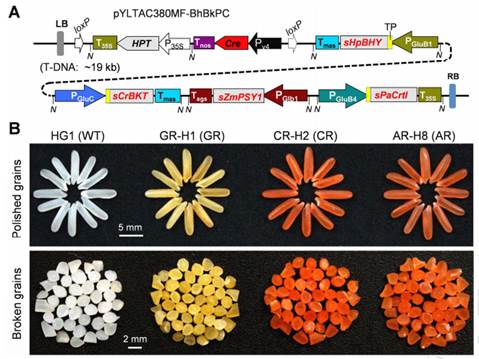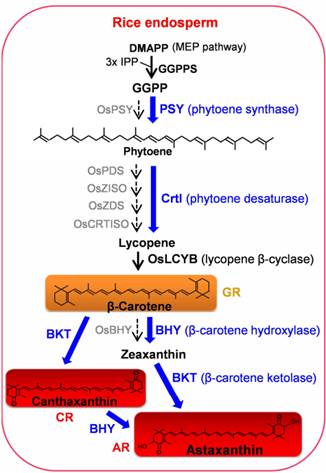华南农大利用代谢工程创制“赤晶米”新种质


记者从华南农业大学获悉,该校生命科学学院、亚热带农业生物资源保护与利用国家重点实验室刘耀光院士团队利用高效的多基因载体系统TGSII(TransGene Stacking II),实现了在水稻胚乳特异合成虾青素的营养强化目标,培育出世界首例胚乳富含虾青素的新型功能营养型水稻种质“aSTARice,虾青素米”,也称“赤晶米”。相关研究成果10月5日发表在《分子植物》(Molecular Plant)。
据介绍,这是刘耀光院士团队继2017年率先创制富含花青素的功能营养型水稻种质“紫晶米”后,又一重要科研成果。该系列成果为我国开发、储备了一批营养价值高、色彩丰富的水稻新种质,极大地推动了植物合成生物学和作物生物强化研究领域的发展,表明该校在植物多基因转化技术和复杂代谢途径的基因工程领域继续保持了国际领先水平。
类胡萝卜素是一类重要的植物营养素,而虾青素是一类橙红色类胡萝卜色素,为类胡萝卜素的最高级形式,具有超强抗氧化活性。目前已在烟草、番茄、土豆、玉米、生菜等植物中实现了虾青素的合成。然而,由于水稻胚乳中完全缺乏类胡萝卜素前体,在水稻胚乳合成有效虾青素的研究仍未见报道。
刘耀光院士团队通过分析水稻类胡萝卜素合成途径基因的表达模式,发现大多数类胡萝卜素合成的相关基因在水稻胚乳中处于不表达或低表达状态。在此基础上,结合对“黄金大米(Golden Rice)”的分析,确定了八氢番茄红素合成酶基因(sZmPSY1)、八氢番茄红素脱氢酶基因(sPaCrtI)、β-胡萝卜素酮化酶基因(sCrBKT)和β-胡萝卜素羟化酶基因(sHpBHY)四个类胡萝卜素合成途径的关键基因,利用水稻胚乳特异性启动子和自主开发的高效多基因TGSII系统,在水稻胚乳中重新构建了不同基因组合的类胡萝卜素/酮式胡萝卜素/虾青素的生物合成途径。
该研究结果表明:双基因(sZmPSY1和sPaCrtI),三基因(sZmPSY1, sPaCrtI和sCrBKT)和四基因(sZmPSY1, sPaCrtI, sCrBKT和sHpBHY)聚合转化水稻,分别获得了筛选标记删除,富含黄色β-胡萝卜素的黄金大米、橙红色的角黄素大米和虾青素大米新种质。从而证实,导入上述四个基因的最小组合就能够在水稻胚乳中实现虾青素的从头生物合成,获得富含高抗氧化活性虾青素的虾青素大米。(来源:科学网)
From Golden Rice to aSTARice: bioengineering astaxanthin biosynthesis in rice endosperm
Abstract Carotenoids are important phytonutrients with antioxidant properties, and are widely used in foods and feedstuffs as supplements. Astaxanthin, a red-colored ketocarotenoid, has strong antioxidant activity thus can benefit human health. However, astaxanthin is not produced in most higher plants. Here we show the bioengineering of astaxanthin biosynthesis in rice endosperm by introducing four synthetic genes (sZmPSY1, sPaCrtI, sCrBKT, and sHpBHY) encoding the enzymes phytoene synthase, phytoene desaturase, β-carotene ketolase, and β-carotene hydroxylase, respectively. Overexpression of two (sZmPSY1 and sPaCrtI), three (sZmPSY1, sPaCrtI and sCrBKT) and all four of these transgenes driven by rice endosperm-specific promoters established the carotenoid/ketocarotenoid/astaxanthin biosynthesis pathways in the endosperm, thus resulting in various types of germplasm, from the yellow-grained β-carotene-enriched Golden Rice to orange-red-grained Canthaxanthin Rice and Astaxanthin Rice, respectively. Grains of Astaxanthin Rice were enriched with astaxanthin and had higher antioxidant activity. The results proved that introduction of the minimal set of the four transgenes enables de novobiosynthesis of astaxanthin in the rice endosperm. This work provides a successful example for synthetic biology in plants and biofortification in crops; the products of this study could be consumed as health-promoting foods and processed to produce dietary supplements.
原文链接:https://www.cell.com/action/showPdf?pii=S1674-2052%2818%2930302-2

